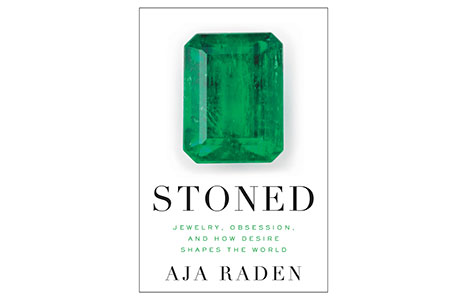9 Surprising Facts About Rare Jewels
by Natasha Wolff | November 27, 2015 10:00 am
If you ask jewelry designer and historian Aja Raden to name one of the big loves of her life, she will, without question, say jewels.
“As a little kid, I would take anything shiny—even fake jewelry—and stash them away in treasure boxes,” she admits. “It’s been a singular obsession of mine for as long as I can remember.”

Stoned
So much so that she’s written a book solely dedicated to the precious stones[1]. Titled Stoned[2], the tome—on sale December 1— tackles everything from how jewels shaped the course of history to the psychological implications of desiring valuable (and beautiful) pieces.
In honor of the launch, Raden shares little-known tidbits about rare jewels with DuJour.
1. Rubies are just red sapphires.
They’re not their own stone, but rather sapphires that have soaked up an excessive amount of chromium and turned red. Some people are disappointed if they have one, but on the other hand, your sapphire was so special that it got its own name!
2. Real amber floats and smells good.
For most of history, until very recently, amber was fished for. If you rub it really hard with fabric for a minute, it has this beautiful smell to it.
3. Real jet spontaneously combusts if you have too much of it in one place.
It’s nothing you need to worry about in your jewelry box[3], but in the Victorian era, whole jet stores in Witney, a city in the north of England, would sometimes burn down overnight because the jet spontaneously combusted.
4. Almost every pearl you’ve ever seen was cultured.
Most people think cultured pearls are cheap pearls, but since the ‘30s, all pearls are cultured[4], even the big, ragged-looking ones. It’s good because oysters were going extinct at the turn of the century.
5. Rub a pearl across your teeth to know if it’s real.
If you rub a fake pearl across your teeth, it will feel smooth, but a real pearl will feel rough no matter how smooth it looks. That’s because pearls were made in the same way teeth were made, through mineralization. Most jewelers won’t mind you doing this because it doesn’t hurt the pearls and it’s a good way to tell if you’re buying fake pearls!
6. Pierre Cartier traded a double-strand of natural pearls (before they were cultured) for a mansion on Fifth Avenue in New York in 1917.
That was an even trade. That mansion remains, to this day, the headquarters of Cartier. It’s amazing when you go in there and think about the prices of real estate in New York. You can’t help but think, this was worth a necklace.
7. Sapphires were the first synthetic gemstone.
A man named Bernoulli perfected the process of growing a sapphire right in his lab right before the turn of the century.
8. Opals are like sponges because of the way they’re formed.
If you get them wet with something dirty, they suck it up and change color to a murky grey. Be careful!
9. Some calcium supplements are made out of pearls.
When pearls are cultured, a lot of them end up too small or funny looking. Before throwing them away, some pharmaceutical companies ground them up and turn them into calcium supplements.
- precious stones: http://dujour.com/gallery/silver-jewelry-with-diamonds-pearls-gems/
- Stoned: http://www.harpercollins.com/9780062334718/stoned
- jewelry box: http://dujour.com/style/jewelry-organization-tips/
- pearls are cultured: http://dujour.com/gallery/baroque-pearl-jewelry/
Source URL: https://dujour.com/style/stoned-aja-raden-book-rare-jewel-facts/